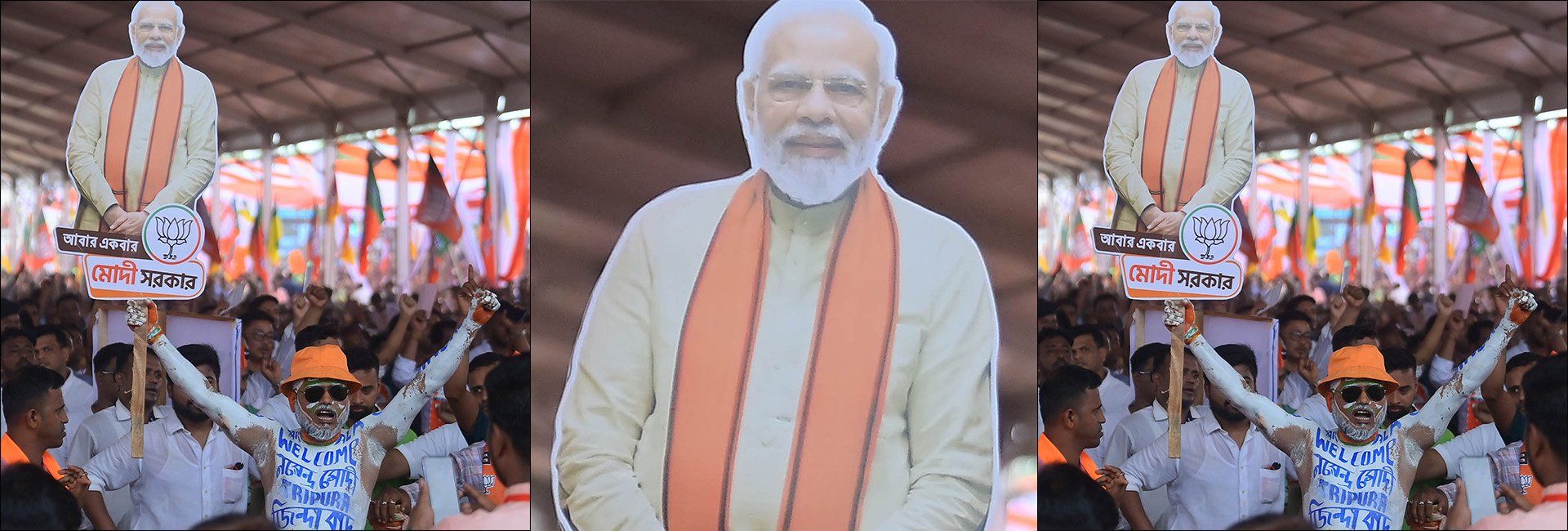Western and Indian media find different narratives in Narendra Modi's weak victory.
It was supposed to be a coronation for Narendra Modi but instead it has become India’s “War of Alliances”. Before the results in India’s Lok Sabha general parliamentary election were released this week, Modi was seen as invincible, his path to becoming only the second leader to serve three terms at the head of world’s largest democracy, a certainty.
The elections were conducted across six weeks and the exit polls over that time forecast a Modi landslide. Instead, the contest between Modi’s National Democratic Alliance (NDA) and Rahul Gandhi’s Indian National Developmental Inclusive Alliance (INDIA) was close.
Since those results were announced on June 4, India’s political class has been in a frenzy of speculation and negotiation. Everyone, from hard-core Modists to critics of the nationalist leader have been taken aback by the twists and turns in this “War of Alliances”.
Need to know
- The election ran across six weeks, in seven phases.
- The party which wins a majority in Lok Sabha, the lower house of the parliament, forms government.
- A political party or coalition needs 272 votes to form the majority of the 543-seat lower house.
- More than 640 million people voted.
The elections has concluded with a third consecutive term for Modi and his NDA coalition, however, the final count has left the prime minister and his party walking a tightrope to secure that third term.
Modi had opened his re-election campaign with the Hindi slogan: “Abki baar 400 paar” which translates as “this time, more than 400 [seats]” of the 543 seats. He expected his Bharatiya Janata Party to win more than 300 and potentially govern in its own right, without coalition partners. In fact, the BJP won only 240 seats and has had to stitch together a coalition from its alliance partners.
The incredible shrinking Modi
Interpreting what message the election results are sending might depend on where you read your analysis. In the West, where the Modi narrative has been of a cult-like Hindu nationalist rockstar figure, the shock was palpable. “For the first time in years, Modi seemed vulnerable,” said The Washington Post.
The Post reported “tepid support for his Hindu nationalist party, piercing the air of invincibility around the most dominant Indian politician in decades” while the BBC headlined it a “Stunning blow for Modi as alliance heads for reduced majority”.
The New York Times also focussed on the Modi factor. “The prime minister will keep his job, but his aura has been diminished and his leadership has fundamentally changed” and as result India’s “Multiparty democracy springs back to life”.
In Australia, ABC News reported on a “victory that feels like a defeat”.
'The reality is that Modi has led his nation away from being a stronghold of democracy.'
“Modi initially focused his campaign on his economic achievements over the past decade and commitment to Hindu revivalism,” ABC reported. “But he soon switched to targeting the main opposition Congress Party, accusing it of favouring India's minority Muslims – which the party denies.”
The Indian Sun, a Victoria-based publication catering to Australia's Indian diaspora, noted the implications for the India-Australia bilateral relationship: “Both countries will likely continue to enhance their economic, strategic and cultural ties, ensuring a strong and mutually beneficial relationship.”
The Sydney Morning Herald, in its editorial, was less positive, cautioning Australia to “tread lightly” with its strategic ally, writing “the reality is that Modi has led his nation away from being a stronghold of democracy to a new reality where press freedom, civil liberties and human rights activists are routinely sacrificed to sectarian hegemony”.
Forget Modi, it’s the economy
At home in India, the post-election coverage there has been comparatively less talk about Modi’s personality cult or his Hindu Nationalist agendas and more in-depth examination of election campaigns in various constituencies. Uttar Pradesh, historically a BJP stronghold, there has been deep local dissent due to massive unemployment, threats to democratic institutions and rhetoric of “changing the Constitution”. The BJP did not win the state.
The Indian Express said the BJP had depended too much on Modi’s allure and the massive unemployment has left young people disgruntled. The Hindu newspaper, in analysing the Uttar Pradesh results, noted the Opposition’s speeches “raised issues that people could identify with” such as unemployment and bungled governance, specifically the cancellation of a police entrance exam after the test paper leaked impacting millions of applicants.
The Hindu called out the BJP Chief Minister: “UP Chief Minister Yogi Adityanath is a Hindutva hard-liner who wears his religiosity literally on his sleeve and does not shy away from blatant dog-whistling and minority-bashing to secure votes for his party.”
“The road to Delhi runs through Uttar Pradesh , [that] is not lost on anyone,” wrote The Indian Express.
This cycle, Uttar Pradesh voted for Samajwadi Party, breaking the BJP’s reign. The victory was key to the INDIA parties election success, capturing 232 seats. The alliance is led Gandhi’s Congress Party, along with major parties including Trinamool Congress (TMC) which governs the state of West Bengal, Aam Aadmi Party (AAP), prominent in Delhi and Punjab, Samajwadi Party which overturned the BJP’s hold on Uttar Pradesh and Dravida Munnetra Khazhagam (DMK), which holds fort in Tamil Nadu.
While Modi’s Hindutva politics were not entirely overlooked by the Indian media, there were much more pressing concerns such as regional level caste politics, the country’s dire economic inequality, chronic underemployment and lack of local connection with the government.
The question now, with the War of Alliances election decided, is will an NDA coalition government provide some safeguard to the world's largest democracy; and will it help or hinder India's economic growth.






Afraid of an egg: the tyranny of living with social media's body standards